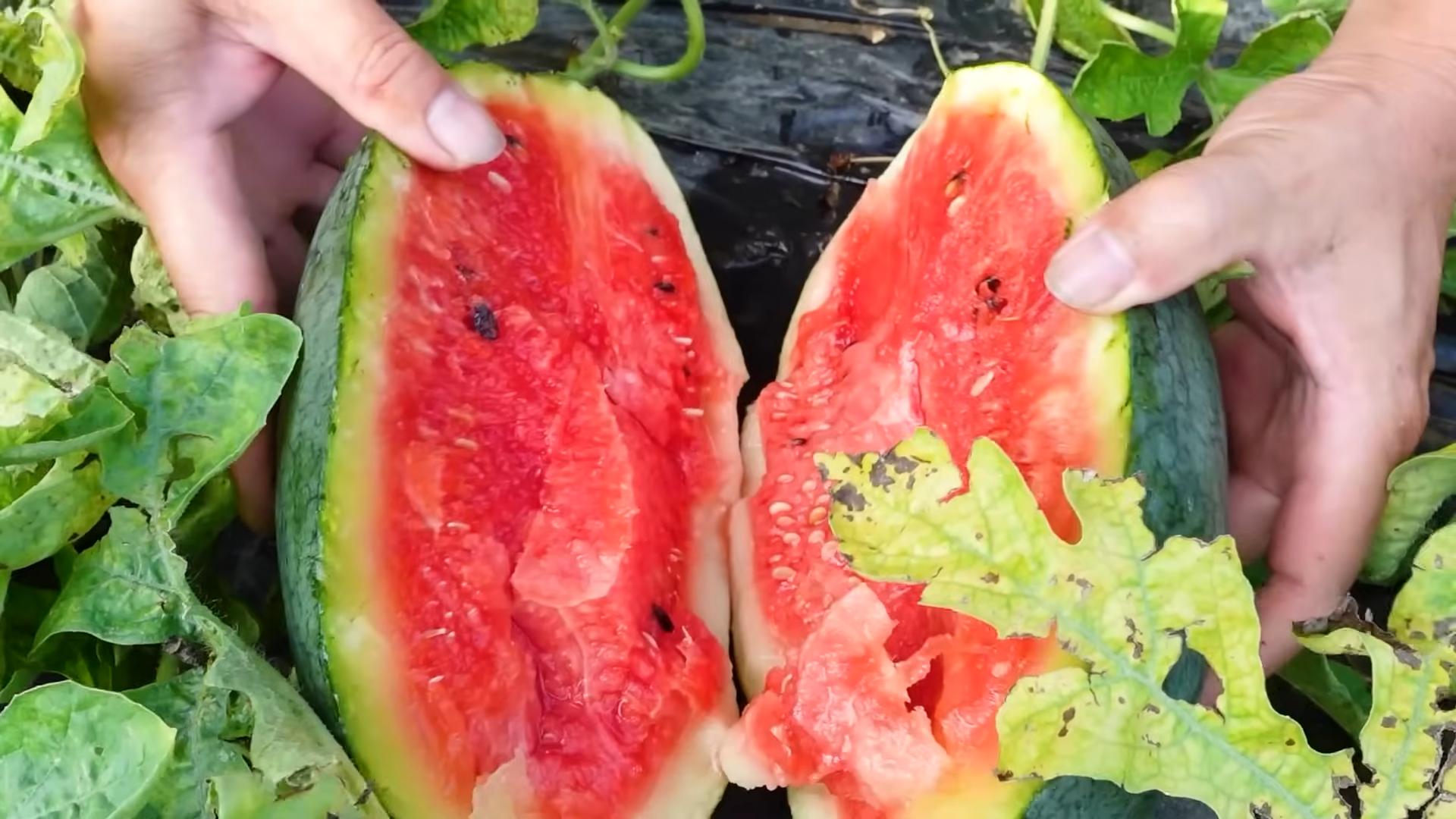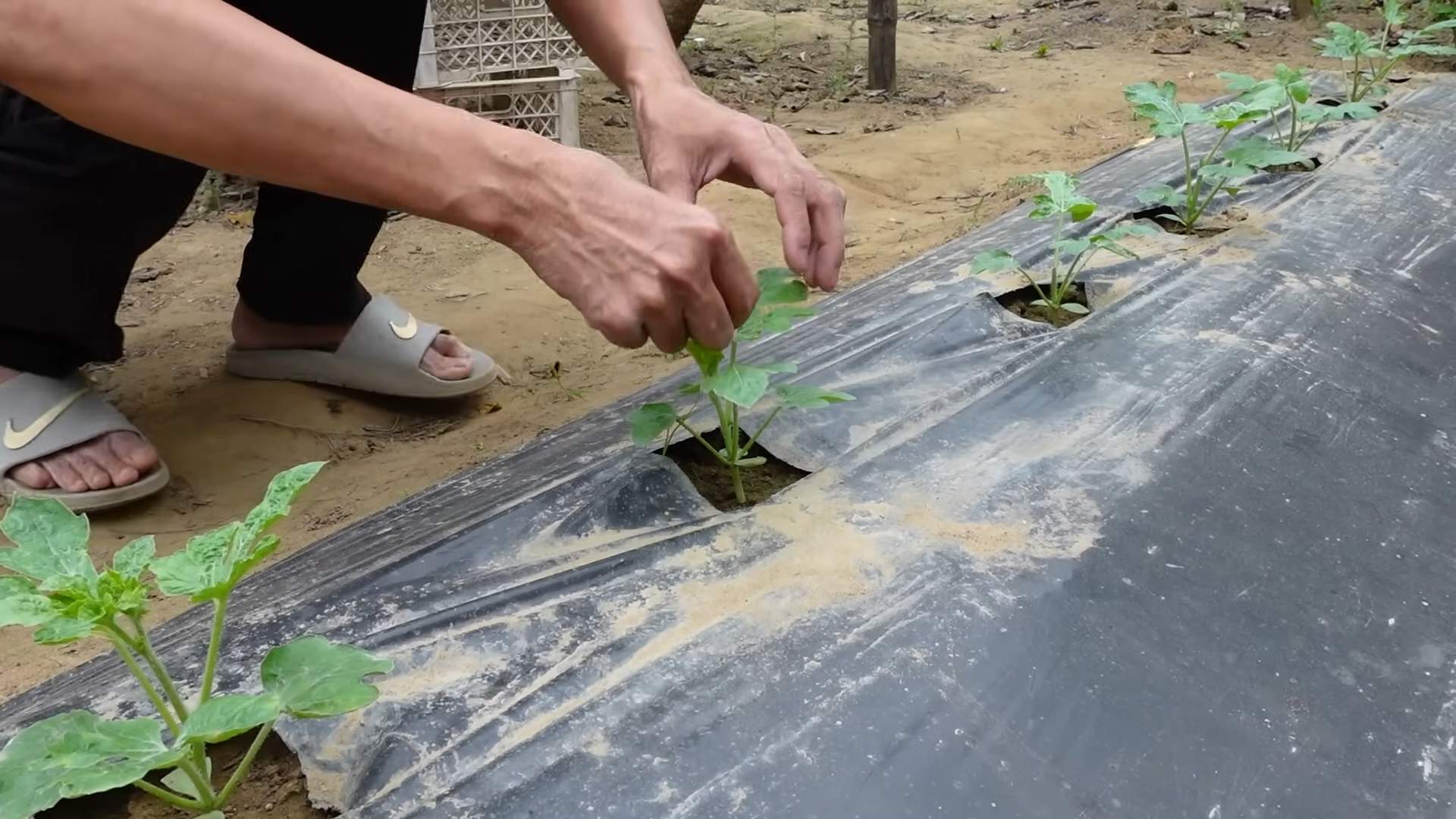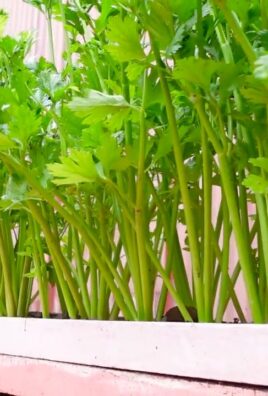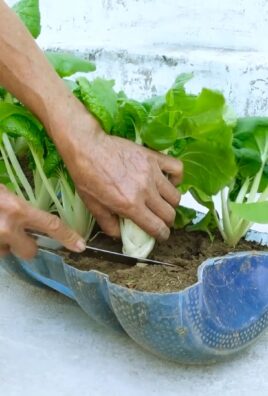Grow Watermelon at Home Easily? Absolutely! Imagine biting into a juicy, sweet watermelon that you nurtured from seed to fruit, right in your own backyard. Forget those bland, store-bought melons – we’re talking about homegrown deliciousness! For centuries, watermelons have been a symbol of summer, abundance, and good times, tracing back to their origins in Africa. Ancient Egyptians even depicted watermelons in their art and placed them in tombs for the afterlife – talk about a refreshing journey!
But let’s be honest, the thought of growing your own watermelon can seem a little daunting. Maybe you think you need acres of land or a green thumb blessed by the gardening gods. That’s where these DIY tricks and hacks come in! I’m here to show you that grow watermelon at home easily is totally achievable, even if you’re a beginner with limited space. We’ll break down the process into simple, manageable steps, covering everything from seed starting to harvesting your prize-winning melon.
Why do you need these DIY tricks? Because who wouldn’t want to enjoy the unparalleled flavor of a homegrown watermelon? Plus, you’ll save money, reduce your carbon footprint, and experience the immense satisfaction of nurturing something from seed to table. So, grab your gardening gloves, and let’s get started on this exciting journey to watermelon paradise!

Grow Your Own Juicy Watermelons: A Beginner’s Guide
Okay, so you want to grow watermelons at home? Awesome! It might seem intimidating, but trust me, with a little planning and effort, you can be enjoying your own homegrown, juicy watermelons before you know it. I’m going to walk you through everything you need to know, from choosing the right variety to harvesting your prize-winning melon. Let’s get started!
Choosing the Right Watermelon Variety
First things first, you need to pick a watermelon variety that suits your climate and garden size. Not all watermelons are created equal! Some are huge, some are small, some are early-maturing, and some are disease-resistant. Here’s a breakdown to help you decide:
* Climate Considerations: If you live in a cooler climate with a shorter growing season, opt for early-maturing varieties like ‘Sugar Baby’ or ‘Bush Sugar Baby’. These varieties ripen faster and are more likely to produce fruit before the first frost. If you have a long, hot summer, you can experiment with larger, later-maturing varieties like ‘Charleston Gray’ or ‘Crimson Sweet’.
* Space Requirements: Watermelons need space – a lot of it! Vining varieties can spread up to 10-15 feet. If you have a small garden, consider bush or compact varieties like ‘Bush Sugar Baby’ or ‘Garden Baby’. These varieties are specifically bred to take up less space. You can also try growing watermelons vertically on a trellis, but you’ll need to provide support for the heavy fruits.
* Taste Preferences: Do you prefer a super sweet, red-fleshed watermelon? Or maybe a more subtle, pink-fleshed variety? Research different varieties and read reviews to find one that matches your taste. Some popular choices include:
* ‘Sugar Baby’: A classic, small, and sweet watermelon.
* ‘Crimson Sweet’: A large, juicy, and flavorful watermelon.
* ‘Charleston Gray’: A long, cylindrical watermelon with a mild, sweet flavor.
* ‘Yellow Doll’: A unique watermelon with yellow flesh and a honey-like flavor.
* ‘Icebox Watermelons’: Smaller varieties perfect for individual servings.
* Disease Resistance: If you’ve had problems with fungal diseases in your garden in the past, look for disease-resistant varieties. This can save you a lot of headaches (and fungicide applications) down the road.
Preparing the Soil
Watermelons are heavy feeders, meaning they need a lot of nutrients to grow and produce fruit. Proper soil preparation is crucial for success.
* Sunlight: Watermelons need at least 6-8 hours of direct sunlight per day. Choose a location in your garden that gets plenty of sun.
* Soil Type: Watermelons prefer well-drained, sandy loam soil with a pH between 6.0 and 6.8. If your soil is heavy clay, amend it with compost, aged manure, or other organic matter to improve drainage and aeration.
* Soil Testing: It’s always a good idea to get your soil tested to determine its nutrient levels and pH. This will help you determine what amendments you need to add. You can purchase a soil testing kit at your local garden center or send a sample to a soil testing lab.
* Adding Amendments: Based on your soil test results, amend your soil with compost, aged manure, or other organic matter. Watermelons also benefit from a boost of phosphorus and potassium. You can add bone meal (for phosphorus) and wood ash (for potassium) to the soil.
* Creating Mounds or Rows: Watermelons grow best in raised mounds or rows. This helps improve drainage and warms the soil faster in the spring. Create mounds or rows that are about 12 inches high and 3-4 feet wide.
Planting Watermelon Seeds or Transplants
You can start watermelon seeds indoors 4-6 weeks before the last expected frost, or you can direct sow them in the garden after the soil has warmed up to at least 70°F (21°C).
* Starting Seeds Indoors:
1. Fill seed trays or small pots with a seed-starting mix.
2. Sow 2-3 seeds per cell or pot, about 1 inch deep.
3. Water gently and keep the soil moist but not soggy.
4. Place the seed trays or pots in a warm location with plenty of light. A heat mat can help speed up germination.
5. Once the seedlings emerge, thin them to one plant per cell or pot.
6. Harden off the seedlings by gradually exposing them to outdoor conditions for a week before transplanting them into the garden.
* Direct Sowing Seeds:
1. Wait until the soil has warmed up to at least 70°F (21°C).
2. Sow 4-5 seeds per mound or row, about 1 inch deep.
3. Water gently and keep the soil moist.
4. Once the seedlings emerge, thin them to the strongest plant per mound or row.
* Transplanting Seedlings:
1. Dig a hole that is slightly larger than the root ball of the seedling.
2. Gently remove the seedling from its pot and loosen the roots.
3. Place the seedling in the hole and backfill with soil.
4. Water thoroughly.
5. Space plants according to the variety’s recommendations. Bush varieties can be planted closer together than vining varieties.
Caring for Your Watermelon Plants
Once your watermelon plants are established, it’s important to provide them with proper care to ensure a bountiful harvest.
* Watering: Watermelons need consistent moisture, especially during fruit development. Water deeply and regularly, especially during dry spells. Avoid overhead watering, as this can promote fungal diseases. Soaker hoses or drip irrigation are ideal.
* Fertilizing: Watermelons are heavy feeders and benefit from regular fertilization. Use a balanced fertilizer (e.g., 10-10-10) every 2-3 weeks. You can also side-dress the plants with compost or aged manure.
* Weeding: Keep the area around your watermelon plants free of weeds. Weeds compete with watermelons for nutrients and water. Mulching can help suppress weeds and retain moisture.
* Pest Control: Watermelons can be susceptible to various pests, including aphids, squash bugs, and cucumber beetles. Inspect your plants regularly for signs of pests and take action promptly. You can use insecticidal soap, neem oil, or other organic pest control methods.
* Pollination: Watermelons need to be pollinated in order to produce fruit. Bees are the primary pollinators. If you’re not seeing many bees in your garden, you can hand-pollinate the flowers. To hand-pollinate, use a small paintbrush to transfer pollen from the male flowers to the female flowers. Female flowers have a small, immature watermelon at the base of the flower.
* Pruning (Optional): Some gardeners prune their watermelon vines to encourage fruit production. You can prune off any side shoots that don’t have flowers or fruit. This will help the plant focus its energy on developing the existing fruits.
* Supporting the Fruit: As the watermelons grow larger, they may need support to prevent them from breaking off the vine. You can use slings made from old t-shirts or pantyhose to support the fruits. For trellised watermelons, make sure the trellis is strong enough to support the weight of the fruits.
Harvesting Your Watermelons
Knowing when to harvest your watermelons is key to enjoying their full flavor and sweetness. Here are a few signs that your watermelons are ripe:
* The Tendril: The tendril closest to the fruit should be brown and dry.
* The Ground Spot: The spot where the watermelon rests on the ground (the ground spot) should be yellow or cream-colored. If it’s still white, the watermelon is not ripe.
* The Thump Test: Give the watermelon a gentle thump. A ripe watermelon will sound hollow. An unripe watermelon will sound dull.
* Days to Maturity: Check the seed packet or plant tag for the variety’s days to maturity. This is a good estimate of when the watermelon will be ripe.
Once you’ve determined that your watermelon is ripe, carefully cut it from the vine with a sharp knife or pruning shears. Leave a few inches of stem attached to the fruit.
Enjoying Your Homegrown Watermelon
Congratulations! You’ve successfully grown your own watermelons. Now it’s time to enjoy the fruits (literally!) of your labor.
* Storing Watermelons: Whole watermelons can be stored at room temperature for up to two weeks. Cut watermelons should be stored in the refrigerator.
* Serving

Conclusion
So, there you have it! Growing watermelons at home might seem daunting at first, but with a little patience, the right techniques, and our easy-to-follow guide, you can be harvesting your own juicy, sweet watermelons in no time. This DIY approach isn’t just about saving money; it’s about experiencing the joy of nurturing a plant from seed to fruit, knowing exactly what went into its growth, and enjoying a flavor that surpasses anything you can find in a store. The satisfaction of biting into a watermelon you grew yourself is truly unparalleled.
But why is this DIY trick a must-try? Firstly, you gain complete control over the growing process. You can choose organic methods, avoiding harmful pesticides and herbicides. Secondly, you can select watermelon varieties that are best suited to your local climate and personal preferences. Want a smaller, personal-sized watermelon? Go for it! Craving a seedless variety? The choice is yours. Thirdly, growing your own watermelons is a fantastic learning experience, connecting you with nature and teaching you valuable gardening skills.
Consider these variations to personalize your watermelon-growing journey. For those with limited space, try growing bush-type watermelons in containers. These compact varieties are perfect for patios and balconies. You can also experiment with different trellising methods to support the vines and maximize space utilization. Another fun variation is to try grafting your watermelon plants onto more vigorous rootstocks, such as squash, to improve disease resistance and overall plant health. Don’t be afraid to experiment with different soil amendments and fertilizers to find what works best for your specific growing conditions. You can also try succession planting, sowing seeds every few weeks, to extend your harvest season.
Ultimately, **growing watermelon at home easily** is an incredibly rewarding experience. It’s a chance to connect with nature, enjoy fresh, healthy produce, and impress your friends and family with your gardening prowess. We encourage you to give it a try! Don’t be discouraged if your first attempt isn’t perfect. Gardening is all about learning and adapting.
We’re confident that with our guide and a little bit of effort, you’ll be enjoying homegrown watermelons in no time. We’d love to hear about your experiences! Share your photos, tips, and challenges in the comments below. Let’s build a community of home watermelon growers and learn from each other. Happy gardening!
Frequently Asked Questions (FAQ)
1. What is the best time to start growing watermelons?
The best time to start growing watermelons depends on your climate. Watermelons are warm-season crops and require a long growing season of at least 70-90 days. In general, you should start seeds indoors about 6-8 weeks before the last expected frost. If you live in a warmer climate with a longer growing season, you can direct sow seeds outdoors once the soil temperature reaches at least 70°F (21°C). Make sure to check your local frost dates to determine the optimal time to start your seeds.
2. What kind of soil do watermelons need?
Watermelons thrive in well-drained, sandy loam soil that is rich in organic matter. The soil should have a pH between 6.0 and 6.8. Before planting, amend the soil with compost or well-rotted manure to improve drainage and fertility. Avoid heavy clay soils, as they can retain too much moisture and lead to root rot. If you have clay soil, consider growing watermelons in raised beds or containers with a well-draining potting mix.
3. How much sunlight do watermelons need?
Watermelons need at least 6-8 hours of direct sunlight per day to produce healthy vines and sweet fruit. Choose a planting location that receives full sun throughout the day. If you live in a particularly hot climate, some afternoon shade may be beneficial to prevent the plants from overheating.
4. How often should I water my watermelon plants?
Watermelons need consistent watering, especially during hot, dry weather. Water deeply and regularly, aiming to keep the soil consistently moist but not waterlogged. Water at the base of the plants to avoid wetting the foliage, which can increase the risk of fungal diseases. As the fruits begin to ripen, you can reduce watering slightly to concentrate the sugars and improve the flavor.
5. What are some common pests and diseases that affect watermelons?
Watermelons are susceptible to several pests and diseases, including aphids, squash bugs, vine borers, powdery mildew, and fusarium wilt. Regularly inspect your plants for signs of pests or diseases. Use organic pest control methods, such as insecticidal soap or neem oil, to control aphids and squash bugs. Prevent vine borers by wrapping the base of the stems with aluminum foil or netting. To prevent powdery mildew, ensure good air circulation around the plants and avoid overhead watering. Choose disease-resistant varieties to minimize the risk of fusarium wilt.
6. How do I know when my watermelons are ripe?
Determining when a watermelon is ripe can be tricky, but there are several indicators to look for. The tendril closest to the fruit should be brown and dry. The spot where the watermelon rests on the ground, called the ground spot, should turn from white to yellow. The rind should be dull and slightly waxy. Finally, when you thump the watermelon, it should sound hollow and deep. With practice, you’ll learn to recognize the signs of a ripe watermelon.
7. Can I grow watermelons in containers?
Yes, you can grow watermelons in containers, but you’ll need to choose a large container (at least 20 gallons) and select a bush-type or dwarf variety. Use a well-draining potting mix and provide regular watering and fertilization. Container-grown watermelons may require more frequent watering and feeding than those grown in the ground.
8. What kind of fertilizer should I use for watermelons?
Watermelons benefit from regular fertilization. Use a balanced fertilizer (e.g., 10-10-10) at planting time, and then switch to a fertilizer with a higher phosphorus and potassium content (e.g., 5-10-10) as the plants begin to flower and fruit. You can also supplement with compost tea or liquid seaweed extract to provide additional nutrients.
9. How can I improve the sweetness of my watermelons?
Several factors can influence the sweetness of watermelons. Ensure that the plants receive plenty of sunlight and water. Avoid over-fertilizing with nitrogen, as this can promote leafy growth at the expense of fruit development. Reduce watering slightly as the fruits begin to ripen to concentrate the sugars. Choose watermelon varieties that are known for their sweetness.
10. What should I do if my watermelon plant is not producing fruit?
If your watermelon plant is not producing fruit, there could be several reasons. Ensure that the plant is receiving enough sunlight, water, and nutrients. Check for signs of pests or diseases that may be affecting pollination. Watermelons require pollination to set fruit, so you may need to hand-pollinate the flowers if there are not enough bees or other pollinators in your area. Make sure the soil temperature is warm enough, as cool temperatures can inhibit fruit set.





Leave a Comment